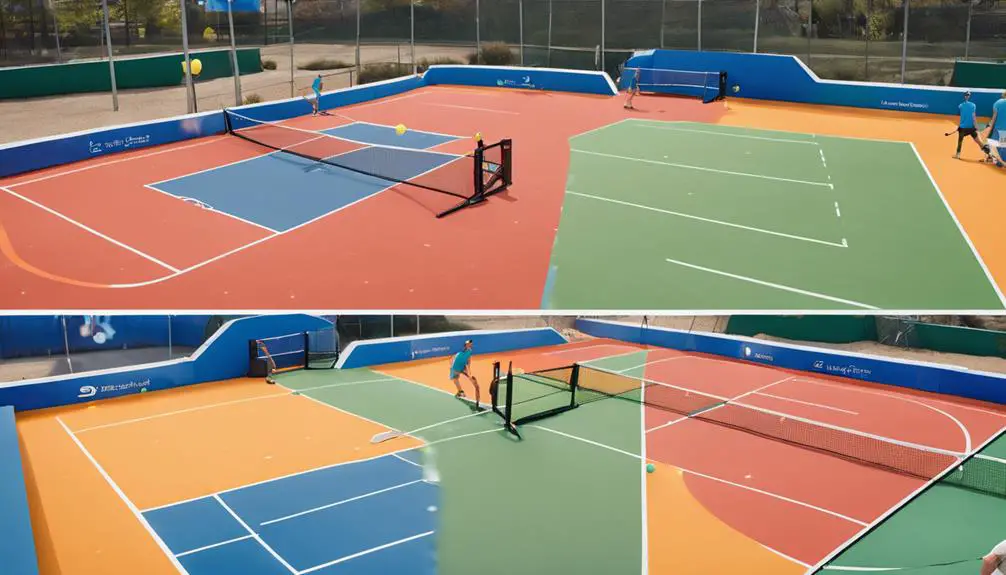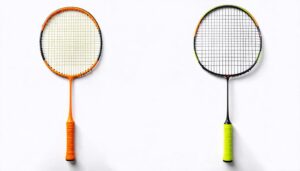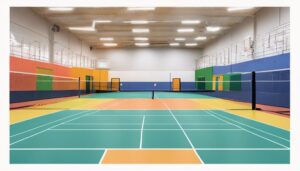When comparing pickleball and paddle tennis, you’ll find distinct differences in gameplay, court size, and rules. Pickleball has a smaller court of 44 feet long and features an underhand serve. The ball is lightweight and perforated, which adds a strategic layer. In contrast, paddle tennis courts are 50 feet long, and players use solid paddles with felt-covered rubber balls, making for a different style of play. Both sports emphasize teamwork and strategy, attracting diverse communities. Each offers unique health benefits, engaging players in fun while improving physical fitness. There’s much more to explore between these two engaging sports.
History of Pickleball

Have you ever wondered how pickleball evolved into the popular sport it is today? The journey of pickleball began in 1965 when three fathers sought a fun activity for their children. They created a game that combined elements of tennis, badminton, and ping pong, laying the groundwork for what would become an international sensation. Early adopters played a vital role in the pickleball evolution, spreading the game through grassroots efforts and community events.
As the sport gained traction, influential players emerged, showcasing their skills and engaging audiences. These pioneers not only contributed to the game’s growth but also inspired modern developments, pushing for organized competitions and national tournaments. The expansion of pickleball saw the introduction of various game variations, catering to different skill levels and preferences, which further broadened its appeal.
The cultural impact of pickleball is hard to overlook. It attracts a diverse demographic, from young athletes to retirees seeking a social activity. The sport’s accessibility and emphasis on community make it a favorite among many. With the rise of social media and increased visibility in recreational centers, pickleball continues to flourish, drawing in new players and champions alike.
In essence, the history of pickleball is a reflection of the power of innovation and community engagement, illustrating how a simple idea can evolve into a beloved pastime that champions freedom, camaraderie, and healthy competition.
History of Paddle Tennis
Paddle tennis boasts a rich history that dates back to the 1920s, when it was first played in the United States as a simplified version of traditional tennis. Its paddle tennis origins can be traced to the desire for a more accessible and less formal alternative to the sport. You might find it fascinating that the game was initially played on small courts and used solid paddles instead of strung racquets, making it easier for players of all skill levels to participate.
As paddle tennis gained popularity, it became a staple of urban recreation, especially in places like New York and California. It wasn’t long before notable tournaments began to emerge, drawing players and spectators alike. By the 1970s, the sport had solidified its place in the American sporting landscape, with organized competitions and a growing community of dedicated players. You’d be intrigued to know that paddle tennis even inspired variations across the globe, each adding its unique flair and rules to the game.
Today, paddle tennis continues to thrive, with clubs and leagues dedicated to fostering a sense of community and competition. Its evolution reflects the spirit of freedom and inclusivity that many players cherish. The game not only serves as a recreational outlet but also as a way for individuals to connect, compete, and enjoy the simple pleasure of play. So, whether you’re a seasoned player or a curious newcomer, paddle tennis offers an engaging experience rooted in a rich history and a vibrant community.
Court Dimensions and Layout

The evolution of paddle tennis has not only influenced its cultural significance but also shaped the physical spaces where the game is played. When you step onto a paddle tennis court, you’ll notice distinct dimensions and layouts that set it apart from pickleball. A standard paddle tennis court measures 50 feet long and 20 feet wide, which creates a more compact playing area. This dimension encourages quick rallies and strategic play, appealing to those who crave fast-paced action.
In contrast, a pickleball court spans 44 feet in length and 20 feet in width, but the game relies on different net height differences. The net in paddle tennis stands at 31 inches, while in pickleball, it’s slightly lower at 36 inches at the ends and 34 inches in the middle. This subtle variation affects the angle of play, influencing how you approach your shots.
Moreover, the choice of court surface materials plays an essential role in the game dynamics. Paddle tennis courts typically feature a hard surface, often made from asphalt or concrete, offering a firm foundation that enhances ball speed and control. In contrast, pickleball courts may utilize a range of materials, including flexible surfaces that can alter bounce characteristics.
Understanding these court dimensions and layouts allows you to appreciate the strategic nuances of both games. Each sport caters to different preferences, creating spaces where players can truly express their freedom and passion for the game.
Equipment: Paddles and Balls
When it comes to equipment, the differences between pickleball and paddle tennis are significant, impacting gameplay and player experience. In pickleball, paddles are typically made from a mix of materials, including wood, composite, and graphite. This variety allows players to choose paddles that suit their playing style. For instance, if you prefer a lightweight option for quick maneuverability, a graphite paddle might be your best bet. On the other hand, paddle tennis paddles are usually crafted from solid materials like foam and rubber, which provide a different feel and level of control during play.
Now, let’s talk about the balls. In pickleball, the ball construction features a plastic, perforated design that’s lightweight and designed for indoor or outdoor play. The holes in the ball affect its aerodynamics, making it less affected by wind, which is essential during outdoor matches. Conversely, paddle tennis balls are often made from a felt-covered rubber, giving them a more substantial bounce and allowing for a more powerful game.
These distinctions in paddle materials and ball construction not only affect how the games are played but also how you, as a player, engage with them. If you value precision and control, pickleball’s paddle options might appeal to you. However, if you’re drawn to a robust, high-energy game, paddle tennis could be your perfect match. Ultimately, understanding these equipment differences can enhance your overall experience in either sport.
Rules of Pickleball

Understanding the equipment differences sets the stage for grasping the rules of pickleball, which play an important role in shaping the game’s strategy and flow. The rules can seem complex at first, but once you break them down, you’ll see how they enhance the enjoyment and competitiveness of the game.
Here’s a quick overview of some key rules:
| Rule Category | Description |
|---|---|
| Serving Techniques | The serve must be underhand, and the paddle must contact the ball below the waist. Players serve diagonally into the opponent’s service court. |
| Fault Rules | A fault occurs if the ball is hit out of bounds, fails to clear the net, or if a player steps into the non-volley zone while volleying. |
| Scoring | Points are scored only by the serving team. Games are typically played to 11 points, requiring a 2-point lead to win. |
| Non-Volley Zone | Players can’t hit the ball in the non-volley zone (often called the kitchen) to prevent aggressive net play. |
Mastering serving techniques is vital as they set the tone for each point. You’ll want to familiarize yourself with the fault rules, as understanding them can drastically impact your gameplay. Each rule exists not just to create structure but to foster a competitive yet fair environment. Embrace these regulations, and you’ll find that they offer the freedom to express your strategic skills on the court!
Rules of Paddle Tennis
Paddle tennis, like its cousin pickleball, has its own set of rules that shape the way the game is played. Understanding these rules is vital to enjoying the sport and ensuring a fair match. First off, let’s talk about serve rules. In paddle tennis, you serve underhand and must keep one foot behind the baseline during the serve. A fault can occur if the ball doesn’t clear the net or lands outside the service box, leading to fault penalties that can impact your game.
Player positioning is significant in paddle tennis. You and your partner should communicate to cover the court effectively. The game typically lasts about one hour, though this can vary depending on the match format, which might include singles or doubles play.
Player conduct is another important aspect of the game. Respect and sportsmanship are essential for maintaining a positive atmosphere on the court. Always be mindful of court etiquette, such as not distracting opponents during their serve and acknowledging good plays.
When it comes to scoring variations, paddle tennis often uses a simplified version. Points are scored only on the server’s serve, and games are usually played to 6 or 8 points.
Scoring Systems Explained

Scoring in paddle tennis differs considerably from other racquet sports, which can impact how you approach your game. Unlike traditional tennis, where players can score points only when serving, paddle tennis allows both players and teams to score on any rally. This fundamental rule creates a dynamic and fast-paced environment, making every point vital.
The most common match formats include singles and doubles, each with its own nuances in scoring. In singles, the game typically plays to 11 points, with players needing to win by at least two. In doubles, the same point system applies, but teamwork becomes essential as you navigate the strategic aspects of the game.
One of the significant scoring differences from pickleball is that paddle tennis uses a traditional deuce system when scores reach 10-10, requiring players to win by two clear points. This can lead to intense, nail-biting finishes that test your mental and physical endurance.
Moreover, the simplicity of the scoring system can be liberating, especially for newcomers. You won’t have to memorize intricate rules or feel overwhelmed by complicated formats. Instead, you can focus on honing your skills and enjoying the game.
Understanding these scoring systems is essential for strategizing your play. By mastering the nuances of paddle tennis scoring, you can adapt your tactics to seize opportunities and maximize your chances of winning. Whether you’re playing casually or competitively, these distinctions can shape your overall experience on the court.
Gameplay Strategies and Styles
Winning in both pickleball and paddle tennis hinges on the players’ ability to adapt their gameplay strategies and styles to the unique demands of each sport. Understanding offensive strategies is essential; you’ll want to capitalize on your opponent’s weaknesses while maintaining aggressive court positioning to create scoring opportunities. In pickleball, quick volleys can be important, while in paddle tennis, you might rely more on powerful serves and overhead shots.
Defensive tactics also play a significant role. You must be prepared to react quickly, using shot selection that keeps your opponent guessing. This might involve soft dinks in pickleball or strategic lobs in paddle tennis, depending on the situation. Court positioning is equally important; staying aware of where you are on the court can help you anticipate and respond effectively to your opponent’s moves.
Teamwork dynamics come into play, especially in doubles formats. Communicating with your partner about player styles and preferred strategies can dramatically enhance your effectiveness. Match preparation isn’t just physical; the mental game is essential. You need to stay focused, read your opponents, and adjust your strategy on the fly.
Ultimately, whether you’re engaging in fast-paced rallies or strategic placements, being flexible in your approach will improve your chances of winning. Embrace the distinctive aspects of each sport, and you’ll find your gameplay becomes not only more effective but also more enjoyable.
Popularity and Community

Both pickleball and paddle tennis have seen a surge in popularity in recent years, drawing in diverse communities of players. The social dynamics within these sports create environments where everyone, from beginners to seasoned athletes, can thrive. Community engagement is often fostered through local clubs, where players gather not just to compete, but to build friendships and camaraderie.
Event participation has skyrocketed, with tournaments popping up across the country, amplifying the tournament culture surrounding both sports. You’ll notice varying player demographics, as these games attract individuals from different age groups and backgrounds. The inclusive nature of both sports encourages youth involvement, ensuring a bright future for their communities.
While paddle tennis has a strong regional popularity in coastal areas, pickleball’s online presence is remarkable. Social media platforms are flooded with content celebrating players, events, and local clubs, making it easier than ever to connect with others who share your passion. This digital engagement helps cultivate a sense of belonging, bringing together players who might never have crossed paths otherwise.
As you explore either sport, consider how the communities around them shape your experience. Whether you’re looking to compete in a tournament or simply enjoy a casual game, both pickleball and paddle tennis offer vibrant communities that celebrate participation and connection. Embrace the opportunity to engage with fellow enthusiasts and contribute to the growing culture surrounding these exciting sports.
Health Benefits of Each Sport
While you might be drawn to pickleball or paddle tennis for the fun and social aspects, the health benefits of these sports are equally compelling. Both sports offer impressive cardiovascular benefits, making them excellent choices for anyone looking to improve heart health and endurance. Engaging in regular play increases your heart rate, promoting better circulation and overall fitness.
Muscle engagement is another significant advantage. You’ll find that both sports require quick lateral movements, which activate various muscle groups. This engagement helps in toning and strengthening your body, particularly in the legs and core. Additionally, the coordination improvement you gain while playing enhances your agility and balance, skills that are beneficial in everyday activities.
Social interaction is a crucial aspect of both pickleball and paddle tennis. Engaging with others while playing not only boosts your mood but also aids in stress reduction. The camaraderie you build can lead to long-lasting friendships, making your fitness journey more enjoyable.
Furthermore, both sports emphasize injury prevention. The lower-impact nature of these games compared to traditional tennis reduces the strain on your joints, making them accessible for players of all ages and fitness levels. This is essential for maintaining an active lifestyle without the risk of serious injuries.
Frequently Asked Questions
What Are the Main Differences in Player Demographics for Each Sport?
Imagine two gardens, each thriving with different blooms. One attracts younger players seeking fast-paced fun, while the other lures seasoned enthusiasts. Age groups and skill levels vary, shaping unique communities within each vibrant sport.
How Do Weather Conditions Affect Gameplay in Pickleball and Paddle Tennis?
Weather impact can considerably alter gameplay strategies. Rain may lead to slippery surfaces, forcing you to adapt your footwork, while wind affects ball trajectory, requiring adjustments in power and precision to maintain control during matches.
Are There Professional Leagues for Pickleball and Paddle Tennis?
While both sports have vibrant communities, you’ll find professional tournaments and league structures more developed in one than the other. Each offers unique opportunities, but the thrill of competition remains a shared passion for players everywhere.
What Are the Common Injuries Associated With Each Sport?
In both sports, common injuries include sprains and overuse issues. To enhance injury prevention, focus on proper warm-ups and cool-downs. Effective rehabilitation strategies can help you recover quickly, keeping your game enjoyable and injury-free.
How Can I Find Local Clubs for Pickleball and Paddle Tennis?
To find local clubs, you can explore local resources like community centers or sports shops. Additionally, check online club directories for listings. Engaging with social media groups can also connect you with fellow enthusiasts nearby.




